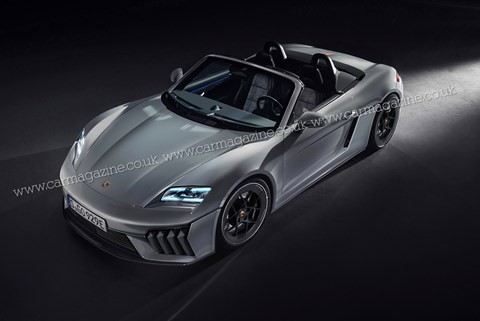The automotive world is electrifying, and Porsche is charging ahead with its iconic sports car lineup. Leading the electric revolution for the Stuttgart-based manufacturer is the highly anticipated Porsche Boxster Ev, along with its coupe sibling, the Cayman EV. While initial timelines have shifted, the buzz around these all-electric successors to the beloved 718 models continues to build. Let’s delve into the details of the forthcoming Porsche Boxster EV, exploring its development, performance expectations, design cues, and what it means for the future of electric sports cars.
Originally slated for production in early 2023, the Porsche Boxster EV (and Cayman EV, codenamed 983) has faced delays, primarily due to challenges with battery supplier Northvolt. Similar to previous setbacks Porsche encountered with battery tech for the hybrid 911 GTS, the reliance on Northvolt for the electric Boxster and Cayman’s batteries has introduced unforeseen hurdles. Despite efforts to mitigate these issues, the production timeline has been pushed back, with the earliest expected launch now projected for October 2025, potentially even slipping into early 2026.
This delay, while frustrating for eager fans, does present a shifting landscape in the electric sports car market. Initially, the Porsche Boxster EV and Cayman EV were poised to dominate the D segment of electric sports cars. However, the emergence of competitors like the MG Cyberster, with its aggressive pricing strategy, means Porsche will now enter a more competitive arena. While Porsche is unlikely to match the Cyberster’s price point, the Porsche Boxster EV is expected to deliver a premium electric sports car experience that justifies its position in the market.
Electrifying Performance: Power and Range of the Porsche Boxster EV
Despite the delay, the specifications and performance targets for the Porsche Boxster EV remain enticing. Porsche is known for its performance pedigree, and the electric Boxster is set to uphold this reputation. While the current combustion engine 718 Boxster models range from 300 to 500bhp, the electric versions promise a significant power surge.
The electric Porsche Boxster EV S models are anticipated to produce around 380bhp and 440lb ft of torque. Stepping up to the GTS spec, enthusiasts can expect a dual-motor setup delivering approximately 490bhp and 550lb ft of torque. Mirroring the Taycan and electric Macan model strategy, a Turbo variant of the Porsche Boxster EV is also expected, with rumored outputs reaching a potent 600bhp and 650lb ft of torque.
Battery technology is at the heart of any EV, and the Porsche Boxster EV is expected to offer impressive specifications in this area. S and GTS models are rumored to feature 89kWh batteries, while the high-performance Turbo variant might boast a larger 99kWh energy pack. The rear-wheel-drive models are reportedly equipped with two electric motors, one for each rear wheel, facilitating advanced torque vectoring. All-wheel-drive versions will incorporate a third motor driving the front wheels, ensuring optimal traction and performance in all conditions.
Early reports from test drivers suggest the rear axle dynamics are particularly noteworthy, offering exceptional torque vectoring capabilities for agile cornering and controlled slides. The Porsche Boxster EV will also benefit from an 800-volt electrical architecture, enabling ultra-fast charging, extended driving range, and enhanced efficiency, aligning it with the Taycan and future Porsche EVs. While details about the battery itself remain somewhat limited, it is known to utilize prismatic cell format, chosen by Porsche for its compact, lightweight, and space-efficient packaging.
Porsche is aiming for a WLTP range exceeding 325 miles for the Porsche Boxster EV, coupled with rapid 15-minute fast charging capabilities. The battery technology is also touted to perform reliably across a wide range of temperatures, crucial for maintaining performance and range in diverse climates. However, concerns regarding battery quality consistency and Northvolt’s financial stability remain, raising questions about the eventual production location of the battery packs for the Porsche Boxster EV.
Mission R Architecture: The Foundation of the Porsche Boxster EV
The underpinnings of the Porsche Boxster EV represent a significant shift for Porsche’s sports car platform strategy. Initially, the 983 was intended to be based on the VW Group’s SSP Sport platform. However, delays within the broader VW Group’s SSP development led Porsche to forge its own path. Frustrated by the slower progress, Porsche developed the Mission R architecture, inspired by the 2021 Mission R concept car.
This bespoke architecture, initially intended for broader use within the VW Group, now appears to be primarily dedicated to Porsche’s sports car ambitions, at least for the foreseeable future. While there were considerations for VW, Cupra, and Audi to utilize the Mission R platform, current plans suggest the Porsche Boxster EV and Cayman EV will be the initial beneficiaries of this dedicated electric sports car architecture.
Spy shots of the Porsche Boxster EV and Cayman EV prototypes reveal familiar Porsche design cues, albeit with evolved proportions to accommodate the electric powertrain. The wheelbase appears to have been extended by 10-15cm to house the T-shaped battery pack, positioned centrally between and behind the seats, optimizing weight distribution and handling.
The wider rear track evident in spy shots suggests accommodation for larger tires, enhancing grip and performance. The elongated rear deck may compensate for the reduced luggage space in the front trunk (frunk) due to the electric components. The centrally located rear charging port, as seen in prototypes, presents a futuristic take on the traditional mid-mounted exhaust. It’s anticipated that wheel and tire options will extend up to 911-spec sizes for customers seeking maximum performance and customization.
The front-end design of the Porsche Boxster EV appears slightly elongated and more pointed, with a lower stance, contributing to aerodynamic efficiency. Automatically adjusting air intakes are visible, suggesting a focus on both low drag and effective cooling. The integration of Porsche’s signature four-point LED matrix headlamps and a full-width rear light bar further solidifies the Porsche Boxster EV‘s place within the Porsche family. Illuminated “Porsche” lettering on the rear light bar is expected as an optional upgrade, enhancing the premium aesthetic. A vertical third brake light is also visible in prototype images, adding a distinctive design element.
Interior and Technology: A Blend of Tradition and Innovation in the Porsche Boxster EV
Inside the Porsche Boxster EV, Porsche is expected to maintain its functional yet driver-focused interior philosophy. Spy shots reveal a familiar three-round instrument cluster, likely to be configurable with various displays, mirroring the Taycan’s digital cockpit approach. Positive changes include the return of physical climate controls and a dedicated volume knob, addressing some user feedback on overly digital interfaces in recent models.
Programmable diamond rocker switches on the dashboard, the traditional rotary drive mode selector on the steering wheel, and an optional passenger display indicate a blend of physical controls and modern digital integration. The gear selector for forward, neutral, and reverse is a compact stub located in the center console, adjacent to the parking brake button. Overall, the switchgear is expected to be consistent with current Porsche models, ensuring familiarity for existing Porsche drivers. The Chrono pack with a stopwatch will likely remain an option, and customizable sound systems will cater to audiophiles.
While massage seats and a more comfort-oriented “Touring” suspension might not be available initially, Porsche is expected to offer performance-enhancing options later in the Porsche Boxster EV‘s lifecycle. A lightweight Weissach pack, 3D bodyform seats, ceramic composite brakes, and aerodynamic kits could become available, allowing owners to further optimize their Porsche Boxster EV for track days or enhanced performance.
Market Readiness and the Future of Electric Sports Cars
Despite the delays, Porsche may find the timing of the Porsche Boxster EV‘s arrival to be more opportune than initially anticipated. While a 32-month delay is significant, the competitive landscape for electric sports cars remains relatively sparse. Excluding the MG Cyberster, direct competitors to the Porsche Boxster EV from BMW, Toyota, Lotus, and Alpine are not yet on the market. The broader EV market may, in fact, be more receptive to the Porsche Boxster EV in late 2025 or early 2026 than it would have been in early 2023.
The initial enthusiasm for EVs has somewhat tempered, particularly within the premium segment. The used values of early Taycan models have seen significant depreciation, and demand for the updated Mk2 Taycan has not met initial expectations. This shift in EV market dynamics, influenced by factors like the US election and ongoing debates about the longevity of combustion engines, presents both challenges and opportunities for Porsche.
To succeed in this evolving market, Porsche needs to deliver Porsche Boxster EVs that are not only sustainable but also emotionally engaging, boasting compelling performance figures and addressing key EV concerns. Fast charging times, extended range, and track-day durability are crucial for convincing traditional sports car enthusiasts to embrace electric power.
While groundbreaking technologies like solid-state batteries and significant weight reduction measures may be further down the line, the Porsche Boxster EV is expected to leverage current technology to its fullest potential. Porsche’s proven track record and stringent engineering standards suggest the 983 will be a highly capable electric sports car. However, convincing die-hard engine enthusiasts to transition to electric will remain a key challenge for the Porsche Boxster EV and the broader electric sports car revolution.

